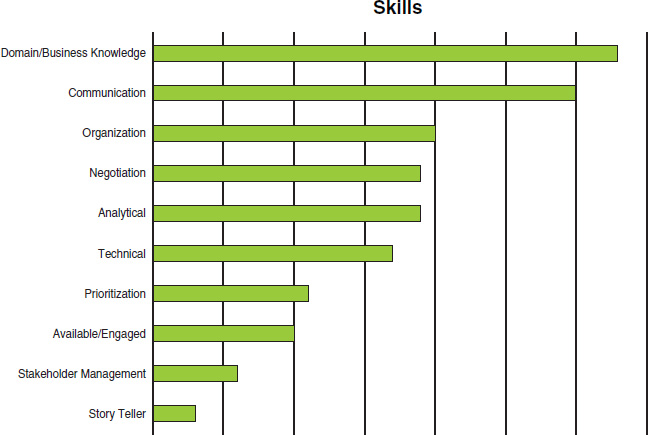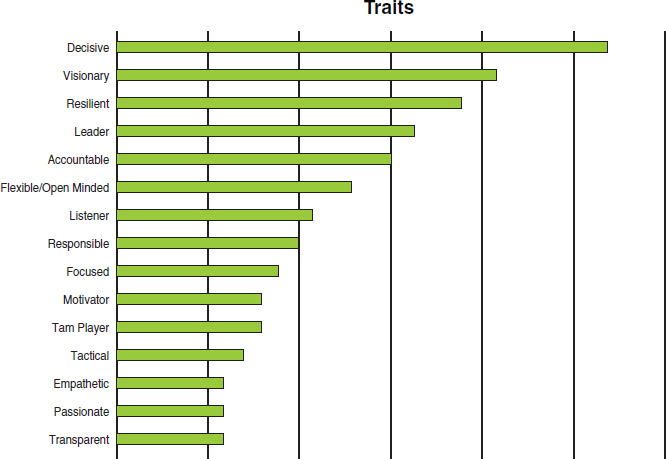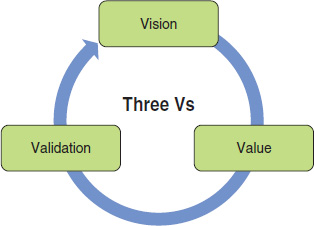9
The Professional Product Owner
Now that the role of Product Owner has been addressed in depth, let’s summarize by examining what it means to be a professional Product Owner. What traits does he have? How does she know when she is successful?
Let’s start by revisiting an image from way back in Chapter 1.

Figure 9-1 Product Owner personality affects outcome
The most successful Product Owners find themselves further along the line in Figure 9-1. Recall that these are more about attitudes and mindsets than titles.
UNDERSTANDING PRODUCT OWNER SUCCESS
Consider the two Product Owner extremes outlined in the next two sections.
THE RECEIVING PRODUCT OWNER
This type of Product Owner often works for a larger corporation and is responsible for an existing product. Upper management provides him with Key Performance Indicators (KPIs) against which he is measured, often in connection with set requirements. This limits being proactive and visionary. Traps of complacency (e.g., “This is just how we do things around here”) make the situation even worse, turning the receiving Product Owner into more of a project manager. Because the strategic aspects of the Product Owner role are not well understood, many organizations equate the role with project management.
If this describes your role, then move toward truly owning the product and step up to do the right things. For example, fight for the right to build a strong dedicated Development Team (or teams) because you will need to rely on them. Make sure that you have enough bandwidth for being a good Product Owner; consider it a full-time job. Move your desk and sit with the Development Team and build a real relationship with them, which will result in a leap forward in productivity.
 I once coached at a large insurance company that had a Product Owner who was allowed to do product work for 50 percent of his time. The remaining 50 percent was for other work. He did a really good job as Product Owner, but the 50 percent proved too little. When I tried to convince his boss to change this, I was told no and that the Product Owner would be assessed at year’s end on the non-Product Owner work. He found himself between a rock and a hard place. Doing good product ownership on 50 percent was not possible, and the remaining 50 percent was more like 100 percent of the workload anyway. In the end, this employee pulled the cord and quit the company for another insurance company.
I once coached at a large insurance company that had a Product Owner who was allowed to do product work for 50 percent of his time. The remaining 50 percent was for other work. He did a really good job as Product Owner, but the 50 percent proved too little. When I tried to convince his boss to change this, I was told no and that the Product Owner would be assessed at year’s end on the non-Product Owner work. He found himself between a rock and a hard place. Doing good product ownership on 50 percent was not possible, and the remaining 50 percent was more like 100 percent of the workload anyway. In the end, this employee pulled the cord and quit the company for another insurance company.
If you are not an expert of the domain for which the product is being developed, then become an expert. Practice Toyota’s approach of Genchi Genbutsu (go to where the work is done). Identify all your stakeholders and go and talk to them, even if it means leaving the building. You need to understand their needs, their fears, their frustrations, and their hopes, so that you develop true customer empathy. Solidify that relationship by using the feedback loop of the Sprint Review. Show that you listen and care about them. For stakeholders who cannot attend the review on a regular basis, find other ways to collect their feedback to show how important their opinion is to you.
THE INITIATING PRODUCT OWNER
This type of Product Owner has all the freedom, even budgetary, to do whatever is needed to realize the product vision. This level of entrepreneurship is most likely at odds with typical technology departments because they won’t have enough connections with management and Development Teams. Talking to people, making deals, networking, spreading the vision, and plowing the field for the product doesn’t allow an initiating Product Owner to spend enough time with the people on the ground.
If this describes your role, then find trusted lieutenants and empower them to assist you wherever needed by providing them with clear goals and insight. Let them find answers and work out the details on their own. Work and its related responsibility can be delegated, but you still stay accountable for the product as only you possess the visionary authority. Take the time to build relationships with the Development Team(s) by relentlessly sharing the product vision and providing feedback.
YOU
These two kinds of Product Owners are at opposite ends of the spectrum and often reflect totally different personalities. Your reality is most likely between these two extremes. Use the guidance provided in this book to tailor your own approach to become a great Product Owner. Try out ideas and measure the results to see whether they are helping or hindering; be empirical.
SKILLS AND TRAITS
When we teach Product Owner courses, the course finishes with an exercise that reflects on the Product Owner role. Participants are asked for the skills and traits of a good Product Owner.
What is a skill and what is a trait?
![]() Traits are who you are; skills are your abilities.
Traits are who you are; skills are your abilities.
![]() Skills are easier to learn whereas traits require a change in personality.
Skills are easier to learn whereas traits require a change in personality.
![]() Performance reviews and interviews are too often focused on skills, such as experience doing something, knowledge of procedures, and quality of output.
Performance reviews and interviews are too often focused on skills, such as experience doing something, knowledge of procedures, and quality of output.
With this description in mind, the participants are asked to list the skills and traits of an ideal Product Owner.
The charts in Figures 9-2 and 9-3 show how often a skill or trait was identified after hundreds of classes and thousands of students.

Figure 9-2 Skills of a good Product Owner
The most important skill is domain and business knowledge followed closely by strong communication skills.

Figure 9-3 Traits of a good Product Owner
The most important trait is being decisive—having the power and ability to make decisions and putting an end to debate—followed by being a visionary.
If you plan to work as a Product Owner, these two charts essentially describe your job.
Example Product Owner job description:
We are looking for a visionary person with excellent business and domain understanding. In your role, we expect you to be a decisive leader displaying strong negotiation skills with all stakeholders and people involved. Your passion for the product and your ability to listen helps you to cope with changes and the occasional setback.
This description is a tall order for sure. Being a Product Owner is not a walk in the park. The Product Owner is a keystone role in Scrum.
Use this list to assess yourself and start working on yourself. There is always room to grow.
In Barry Boehm and Richard Turner’s book, Balancing Agility and Discipline: A Guide for the Perplexed,1 appears an interesting mnemonic to describe an ideal customer: CRACK.
This mnemonic does a good job at summarizing the skills and traits of a Product Owner as well.
Keep Product Owners on CRACK:
![]() Collaborative:
Collaborative:
Work closely with Development Teams and stakeholders. Get to know them. Hand out your cell phone number. Ask them to text or call at any time. Get involved during the Sprint. Don’t wait until the end to provide feedback. See yourself as part of the team.
![]() Representative:
Representative:
Build empathy with your stakeholders and customers. Be their voice when they are not around. Establish and communicate a product vision that accurately reflects their needs. Also represent the Scrum Team by standing up to management that is increasing pressure to deliver.
![]() Authorized:
Authorized:
Be empowered to make any product-related decisions regarding scope, schedule, and budget. Make the final call when stakeholders cannot reach agreement while having confidence that you can adjust your path later when you know more information.
![]() Committed:
Committed:
Product Ownership is a full-time job. Stay committed to the product, the Development Team, stakeholders, and quality. Stay true to the vision, value, validation (the three Vs), and the empirical process that is Scrum. Do not let anything steer you off track.
![]() Knowledgeable:
Knowledgeable:
Know your domain and never stop learning. Work closely with users and subject matter experts to fill in any gaps in your knowledge. Stay on top of the latest technology trends. Examine the marketplace and competition to stay in front.
MEASURING SUCCESS
Ultimately, success of a Product Owner, and consequently the product, comes back to the three Vs (see Figure 9-4).

Figure 9-4 The three Vs
How clear is your product vision? Do the people creating the product know it? Do your stakeholders? Does your Product Backlog reflect the vision? Are your release plan and Sprint Goals in line with the vision?
How are you measuring value? How often are you measuring it? Are you maximizing return on investment? Are your customers happier? How about your Development Team? How much of your budget is being spent on new innovative features that your customers are asking for rather than maintenance?
Are you validating the product with your stakeholders and the marketplace? How often are you doing it? Are you adjusting the product’s direction accordingly? Is the quality of the product consistent enough to release whenever needed?
If you can show positive trends for each of these questions, then congratulations: you are a true professional Product Owner.
____________________________
1. Barry Boehm and Richard Turner, Balancing Agility and Discipline: A Guide for the Perplexed (Boston: Addison-Wesley, 2003).
